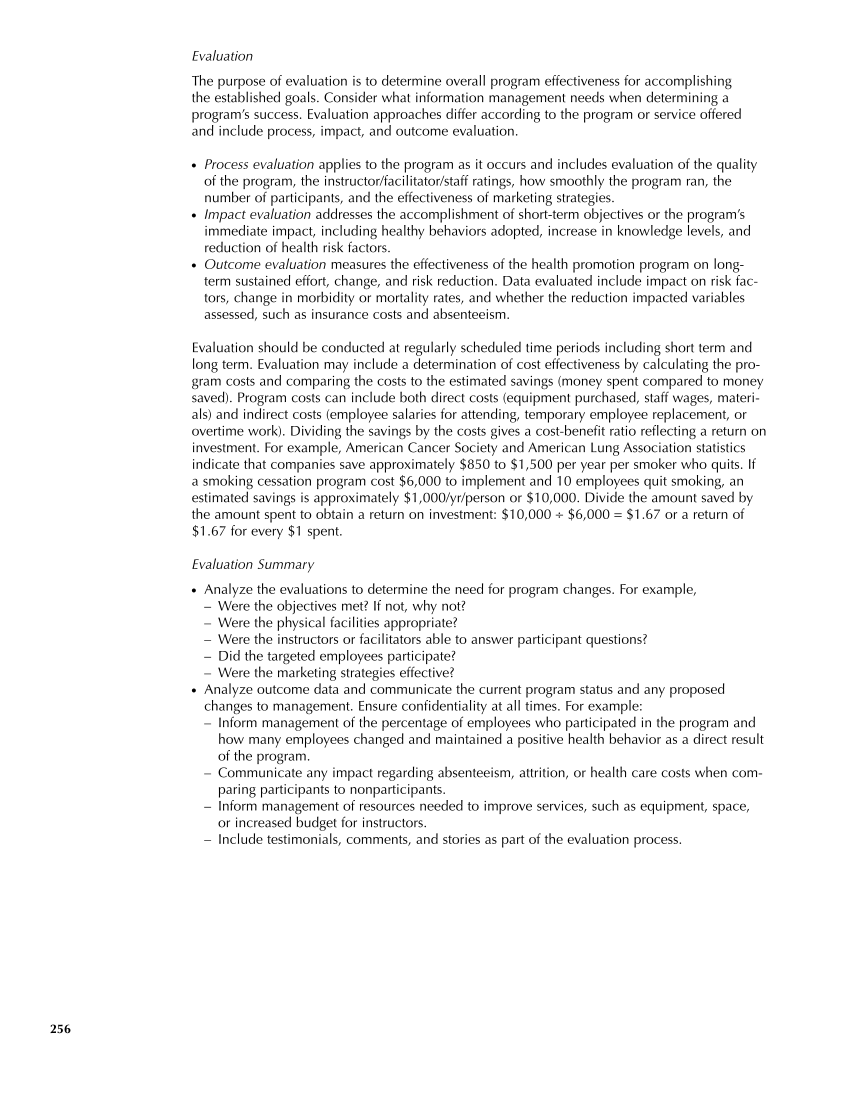Evaluation The purpose of evaluation is to determine overall program effectiveness for accomplishing the established goals. Consider what information management needs when determining a program’s success. Evaluation approaches differ according to the program or service offered and include process, impact, and outcome evaluation. ● Process evaluation applies to the program as it occurs and includes evaluation of the quality of the program, the instructor/facilitator/staff ratings, how smoothly the program ran, the number of participants, and the effectiveness of marketing strategies. ● Impact evaluation addresses the accomplishment of short-term objectives or the program’s immediate impact, including healthy behaviors adopted, increase in knowledge levels, and reduction of health risk factors. ● Outcome evaluation measures the effectiveness of the health promotion program on long- term sustained effort, change, and risk reduction. Data evaluated include impact on risk fac- tors, change in morbidity or mortality rates, and whether the reduction impacted variables assessed, such as insurance costs and absenteeism. Evaluation should be conducted at regularly scheduled time periods including short term and long term. Evaluation may include a determination of cost effectiveness by calculating the pro- gram costs and comparing the costs to the estimated savings (money spent compared to money saved). Program costs can include both direct costs (equipment purchased, staff wages, materi- als) and indirect costs (employee salaries for attending, temporary employee replacement, or overtime work). Dividing the savings by the costs gives a cost-benefit ratio reflecting a return on investment. For example, American Cancer Society and American Lung Association statistics indicate that companies save approximately $850 to $1,500 per year per smoker who quits. If a smoking cessation program cost $6,000 to implement and 10 employees quit smoking, an estimated savings is approximately $1,000/yr/person or $10,000. Divide the amount saved by the amount spent to obtain a return on investment: $10,000 ÷ $6,000 = $1.67 or a return of $1.67 for every $1 spent. Evaluation Summary ● Analyze the evaluations to determine the need for program changes. For example, – Were the objectives met? If not, why not? – Were the physical facilities appropriate? – Were the instructors or facilitators able to answer participant questions? – Did the targeted employees participate? – Were the marketing strategies effective? ● Analyze outcome data and communicate the current program status and any proposed changes to management. Ensure confidentiality at all times. For example: – Inform management of the percentage of employees who participated in the program and how many employees changed and maintained a positive health behavior as a direct result of the program. – Communicate any impact regarding absenteeism, attrition, or health care costs when com- paring participants to nonparticipants. – Inform management of resources needed to improve services, such as equipment, space, or increased budget for instructors. – Include testimonials, comments, and stories as part of the evaluation process. 256
Purchased from OEM Press by (ge corporate access). (C) 2013 OEM Health Information, Inc. All rights reserved.












































































































































































































































































































































































































































